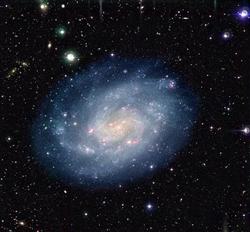A new study using data collected by the W. M. Keck Observatory in Hawaii has revealed that certain fundamental properties of galaxies have actually changed very little over the last 8 billion years, nearly half of the age of the universe.
According to the research, the relationship between a galaxy’s mass and a new speed indicator that measures movement of its stars and gas remains the same for all forms of galaxies, from spirals like our own Milky Way, to elliptical galaxies, and even the so-called “train wrecks” left over by galactic mergers. “Surprisingly, if you use this new speed indicator to measure the motions of stars and gas in a galaxy, you can predict the mass in stars the galaxy has with pretty high accuracy,” said Susan Kassin, a post-doctoral researcher at the University of California, Santa Cruz and lead author of the study.
Galaxies like our Milky Way are made up of billions of stars formed into a spiral disk along with some gas. Like a spinning pinwheel, our galaxy also spins, but at a speed of a few hundred kilometers per second.
It’s known that half of the age of the universe ago, many galaxies looked more disheveled, as they were assembled through galaxy collisions and accretion of new gas and stars. According to the research, disheveled galaxies and the remnants of galaxy collisions had mixed-up velocities in addition to some orderly rotation. Furthermore, the research found that when all these velocities were totaled up, the total amount of motion was found to be similar to that of more well behaved galaxies. “This suggests that the mixed-up velocities may settle down to orderly rotation over time as the universe ages,” said Ben Weiner, a researcher at Steward Observatory at the University of Arizona and a co-author of the study.
Kassin, Weiner, and the other researchers were able to bring together both the Tully-Fisher and Faber-Jackson relations — and include “disturbed” or train-wreck galaxies which previously didn’t figure in either — by using a new speed indicator, a number which when applied to galaxies, allows astronomers to better mathematically define the movement of stars.
“This relation holds for all the galaxies, no matter what they look like,” Kassin said. “It ties together the Faber-Jackson relation with the Tully-Fisher relation and works for all kinds of odd-ball galaxies that are more common in the early universe.”
According to Sandra Faber, co-author of the study and one of the namesakes of the Faber-Jackson relation which she helped develop in 1976, the research is believed to reflect a fundamental property of the universe.
“Both of these relations were imprinted by the nature of fluctuations that made galaxies in the first place,” she said.
The recent study involved 544 distant galaxies of various types, which according to Kassin makes this the largest study to date of the speed and movement of distant galaxies’ stars and other matter. The galaxies studied ranged in redshift from 0.1 to 1.2, which means their light was emitted between 2 billion and 8 billion years ago. Redshift is a way of gauging the distance of an object by measuring how much of the wavelength of its light has shifted toward the redder regions of the spectrum due to galaxies moving away from us because of the expansion of the universe. It is similar to the Doppler Effect which involves changes in sound from an object moving away from oneself.
Kassin said the DEIMOS spectrograph at Keck II, one of two 10-meter telescopes the observatory operates on the summit of Mauna Kea, was key to obtaining the amount of data necessary for the study. “Without it, we wouldn’t have been able to have anything close to this large of a sample,” she said. Additional data came from the Hubble Space Telescope and the Canada-France-Hawaii Telescope, which is also located atop Mauna Kea.The results of the research have been presented in a study to be published in a special issue of Astrophysical Journal Letters devoted to the initial results of a far-reaching study of galaxies know as AEGIS, for All-wavelength Extended Groth Strip International Survey. AEGIS involves nearly 100 scientists from 16 institutions in Europe, North America, and Asia studying a certain area of the sky using a variety of wavelengths ranging from X-rays to radio and including ultraviolet and visible light.











